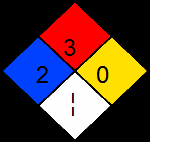
|
|
back
MENU
|
|
Private
|

Safety
NFPA 704 Fire Diamond

NFPA 704 Fire Diamond
Blue/Health
4. Very short exposure could cause death or major residual injury (e.g., hydrogen cyanide).3. Short exposure could cause serious temporary or residual injury (e.g., chlorine gas).
2. Intense or continued but not chronic exposure could cause temporary incapacitation or possible residual injury (e.g., chloroform).
1. Exposure would cause irritation with only minor residual injury (e.g., turpentine).
0. Poses no health hazard, no precautions necessary. (e.g., lanolin).
4. Will rapidly or completely vaporize at normal atmospheric pressure and temperature, or is readily dispersed in air and will burn readily (e.g., propane). Flash point below 23°C (73°F).
3. Liquids and solids that can be ignited under almost all ambient temperature conditions (e.g., gasoline). Flash point below 38°C (100°F) but above 23°C (73°F).
2. Must be moderately heated or exposed to relatively high ambient temperature before ignition can occur (e.g., diesel fuel). Flash point between 38°C (100°F) and 93°C (200°F).
1. Must be pre-heated before ignition can occur (e.g., canola oil). Flash point over 93°C (200°F).
0. Will not burn (e.g., argon).
4. Readily capable of detonation or explosive decomposition at normal temperatures and pressures (e.g., trinitrotoluene).
3. Capable of detonation or explosive decomposition but requires a strong initiating source, must be heated under confinement before initiation, reacts explosively with water, or will detonate if severely shocked (e.g., fluorine).
2. Undergoes violent chemical change at elevated temperatures and pressures, reacts violently with water, or may form explosive mixtures with water (e.g., phosphorus).
1. Normally stable, but can become unstable at elevated temperatures and pressures (e.g., calcium).
0. Normally stable, even under fire exposure conditions, and is not reactive with water (e.g., helium).
The white "banda" area can contain several symbols:
'W' - reacts with water in an unusual or dangerous manner (e.g. cesium, sodium)
'OXY' - oxidizer (e.g. potassium perchlorate)
'COR' - corrosive; strong acid or base (e.g. sulfuric acid, potassium hydroxide)
o 'ACID' and 'ALK' to be more specific.
'BIO' - biohazardous (e.g. smallpox virus)
The radioactive trefoil () - is radioactive (e.g. plutonium)
- 'CRYO' - cryogenic